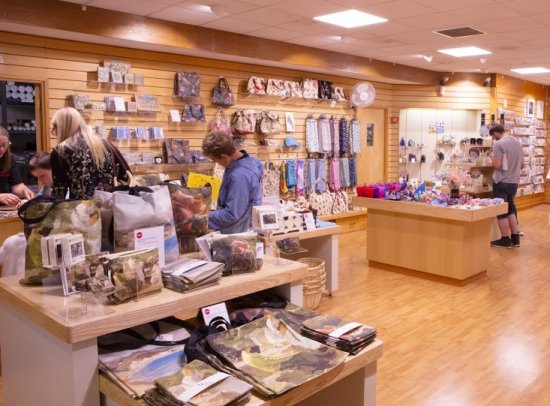
How Bristol Culture turned its retail operation around
Three years ago Bristol’s museum and gallery shops were running without a plan and losing money, but now they are on track to increase revenue by 60%. Zak Mensah tells the story.
I started at Bristol Culture, which includes M Shed and Bristol Museum & Art Gallery, in January 2015. I took on responsibility for seven teams, including retail, which at the time had two ‘physical’ shops. Since then our mantra as a management team has been simple: Run the service as a cultural business and ensure we hit our revenue targets.
We even had a few attempted thefts, which shows that our products are now worth the trouble to risk arrest
The retail operation wasn’t profitable and was performing with a combined spend per head of a mere 28p against a sector benchmark of 50p to £1 for a free-to-enter attraction (calculated by dividing net sales against total visitor number). When I took over, retail had no annual plan, no customer insight, unclear income targets, no performance data, no attention from management, no bespoke products, few resources and no staff development. Few staff would even shop in our own shops. Thankfully we had a team that was up for the challenge.
A realistic approach
I was realistic and gave us 12 months to rebuild our retail operation from the ground up and turn a profit. Once profitable, we could grow. I have a five-year forecast that requires retail to be a £500,000+ business within three years and deliver annual profits of £100,000+. Profitability is the only metric that counts.
For each of my teams I consider three things:
- Scale: how much can I scale up the operation
- Scope: what are the opportunities and constraints
- Speed: how quickly can I make a positive impact.
I didn’t have time to learn everything myself and thus enlisted the support of an independent retail consultancy. Retail Thinking has supported me to improve our buying and merchandise, stock control, retail environment, visual merchandising and display, training and skill levels, online trading and marketing.
Research and data
A core principle of the service is to understand the needs of our customer. If we can meet their need then we have a viable business opportunity. We started with two projects: first, enlist our in-house user researcher to tell us about our museum visitors; and second, install a scalability till system (EPOS) that would tell us in great depth about current customer behaviour.
Collecting, sharing and using data is another core principle. We collected data for six to nine months and shared it with everybody who was interested. We married this data together to form a picture that gave us the confidence to increase our product range and low-price points, of 50p to £20, to as high as £200 based on our visitor demographic.
Product enhancement
We also surveyed both staff and customers to discover what the main issues were. The result of this effort led us to invest about £25,000 in partial shop refits at both shops to allow us to stock a better assortment of products that could look their best. New shelving, lighting and fittings were implemented. Immediately we saw an improvement in our customer satisfaction and average transaction value. By March 2016 we had become profitable. Just. We now had a solid foundation to scale up our efforts for 2016/17.
We then focused on our product offer, eliminating about 1,000 lines across our shops that weren’t popular or relevant. We introduced a collection of products using objects from our own collection and introduced an online shop. We launched a dedicated retail offer at Blaise Castle House Museum that saw sales increase by 1,582%.
We made plenty of small mistakes too, such as buying too much product at a poor margin, missing key events, not hustling our suppliers enough on improved terms and more besides. Yet sales overall increased by a healthy 26% which helped reduce a key performance indicator – cost per transaction. We started to see staff return to our shop and become our biggest advocates.
We even had a few attempted thefts, which shows that our products are now worth the trouble to risk arrest. We accidently break far more products than any theft would cost us, so it’s a problem I’m happy to deal with… so long as they remain isolated incidents.
For 2017/18 we were better prepared for Chinese New Year, exhibition-related products and Christmas. With three months of trading still left, we are already only 3% behind the entire revenue of 2016/17 and on track to increase our revenue by 60% since 2015 to around £500,000 in sales.
Learning and experimentation
We have learned a tremendous amount in a short period of time and like to share our journey with others in the sector. I’m particularly grateful to the other organisations who have allowed me to poke and pry into their retail operations to help us learn quickly.
We need to test assumptions as quickly as possible and experimentation is the key to increasing sales. For example, we successfully scaled up a tiny pop-up shop experience from a few days in 2016 to over 60 days in 2017, worth 5% of total sales. We now collect vast amounts of potentially useful data that requires specialitst skills to turn into usable insights, which is a challenge I’m relishing for 2018.
Other upcoming projects include a further Bristol Museum & Art Gallery shop extension, automation of processes, an M Shed guide book, more bespoke products – and of course making more mistakes.
Zak Mensah is Head of Transformation at Bristol Culture, Bristol City Council.
labs.bristolmuseums.org.uk
Tw @zakmensah

Join the Discussion
You must be logged in to post a comment.